AYESHA "She Who Must Be
Obeyed" and ALLAN QUATERMAIN African Adventurer. The two most famous
creations of English novelist H. RIDER HAGGARD. This is a look at these two
literary characters on the motion picture screen.
Henry Rider Haggard better known
simply as H. Rider Haggard was born June 22, 1856 in Bradenham, Norfolk,
England. In 1875 his father sent him to what is now South Africa to become an
assistant, without pay, to the Secretary of Sir Henry Bulwer, the :Lieutenant
Governor of the Colony of Natal. The young Haggard would remain in Africa
through 1882.
In 1882 Haggard also published a
book on the political situation in South Africa and followed it with a few
unsuccessful novels. Then in 1885 H. Rider Haggard published "King
Solomon's Mines" and created the character of "Allan
Quatermain".
The work is considered the first of what became known as the "Lost World Literary Genre". That authors such as Sir Arthur Conan Doyle and American Edgar Rice Burroughs would make popular. Haggard had been offered 100 pounds for the copyright, but asked for, and received a ten percent royalty from the sales of the novel. As of this writing the sales of "King Solomon's Mines' has reached 63 million copies and continues to be popular adventure reading.
Both the comic book series and motion picture "The League of Extraordinary Gentleman" have reignited an interest in Haggard's "Allan Quatermain".
The work is considered the first of what became known as the "Lost World Literary Genre". That authors such as Sir Arthur Conan Doyle and American Edgar Rice Burroughs would make popular. Haggard had been offered 100 pounds for the copyright, but asked for, and received a ten percent royalty from the sales of the novel. As of this writing the sales of "King Solomon's Mines' has reached 63 million copies and continues to be popular adventure reading.
Both the comic book series and motion picture "The League of Extraordinary Gentleman" have reignited an interest in Haggard's "Allan Quatermain".
My blog is of course about
Motion Picture and Television History, but for those interested in H.
Rider Haggard. The official website of the "H. Rider Haggard
Society" may be found at:
"King Solomon's
Mines" wasn't the first source for the
motion picture industry based upon 12 of Haggard's novels. The first film
version was about "Ayesha", but better known as simply as "SHE".
SHE the Novel
"SHE: A History of
Adventure" was first published in the British
magazine "The Graphic", between October 1886 to
January 1887.
The basic story is a first person
narrative by "Professor Horace Holly". About how he accompanied his
ward "Leo Vincey" and found the "Lost Kingdom" of
"Kor". A face of a women hunts "Leo Vincey" in his dreams
and this draws "Holly", "Leo" and their servant
"Job" to Africa.
Crossing the desert they meet a man
named "Billali" and his Arab group. They rescue the three men from
the heat and thirst of the Sahara desert and takes the three adventurers to
"Kor". There they meet the Kingdom's "White Queen Ayesha",
"She Who Must Be Obeyed", and the women of "Leo's" dreams.
As the story continues the reader
discovers that "Leo" is the reincarnation of
"Ayesha"s" lost love the Greek Warrior, she murdered in
rage, "Kallikrates". "Ayesha" had become immortal by
bathing in the "Blue Cold Flames" of the sacred "Pillar of
Fire". This was 2,000 years before the events in Haggard's story begins.
"Ayesha" wants "Leo" to enter the "Pillar" when
it turns "Cold Blue" once more and reunite their lost love. To prove
entering the "Pillar of Fire" is safe for "Leo".
"Ayesha" enters after the flames again have turned blue, but instead
of retaining her beauty. That second time removes "Ayesha's"
immortality and 'SHE' ages turning to dust. However, as this
is happening "Ayesha" promises to return again.
SHE the Silent Motion Pictures
The first motion picture taking inspiration from Haggard's
novel was by French film make George Melies. Who is better known for
1902's "A Trip to the Moon" based on the Jules Verne
novel "From the Earth to the Moon".
The original French title for this
1899 silent short was "Dance due feu (Dance of Fire)". The
one minute short was known in the United States as "Haggard's
'She'--The Pillar of Fire". This was another of Melies trick
films and is based upon "Ayesha" entering the "Pillar of
Fire" at the novels climax. The viewer sees, in tinted color,
"Ayesha" stand upon the Pillar, the flames appear and she bathes in
them.
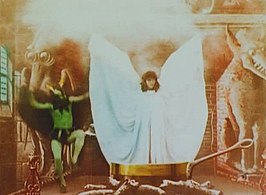
In 1911 there was a 24 minute silent
version of "SHE". Marguerite Snow portrayed
"Ayesha" and James Cruze was shown as "Kallikrates" in Part
One and Leo Vincey in Part Two. This was a message version of Haggard's work
made by the Mormon Church.


February 1916 saw a British silent
version of "SHE". There appears to be no
surviving photos, or film footage of the production. We do know that French
actress Alice Delysia was "Ayesha" and Henry Victor was "Leo
Vincey".
The following year on April 23, 1917
an American production was released starring Indiana born Valeska Suratt as
"Ayesha" and Ben Taggart as "Leo Vincey".


This 1917 production is considered "Lost".
The first major production of the
novel was made in 1925 with the actual participation of H. Rider Haggard. Who
wrote the English language title cards also. The motion picture was a German
and British co-production strangely released first in Portugal on June
21, 1925.
American Betty Blythe was
"Ayesha". Blythe was notorious for being one of the first actresses
to appear totally, or sometimes just partial nude on screen. In 1921 she had
the title role in the motion picture "The Queen of
Sheba". American Carlyle Blackwell was "Leo Vincey" and
in 1929 he portrayed "Sherlock Holmes" in "Der Hund von
Baskerville". Both American's appeared in many German silent
films.


Because of H. Rider Haggard's
involvement the screenplay by Walter Summers is the most faithful version, as
of this writing, to the original story and text. The production ran slightly
more than one hour and thirty-four minutes.
SHE the Sound Motion Pictures
The first sound version of H. Rider
Haggard's novel was produced by Merian C. Cooper. Any true film buff
immediately recognizes Cooper's name as being the man who brought "King
Kong" to the motion picture screen in 1933. Cooper was the real
life "Carl Denham" of that motion picture and also, among other
things, a spy for the "Office of Strategic Services (O,S,S,)"
the precursor to the "Central Intelligence Agency (C.I.A.)". His
amazing and maybe unbelievable life story can be read on my blog at:


Released July 12, 1935 Merian C.
Cooper's version of "SHE" had four interesting
leading actors.
The first was Helen Gahagan as
"Ayesha". Although that name is never used in Dudley Nichols and Ruth
Rose's screenplay. Gahagan is either referred too as "SHE", or
"SHE Who Must Be Obeyed".
Helen Mary Gahagan was actually a
Broadway opera singer and actress. This was her only feature film and later
Gahagan became involved in California politics. After she married actor Melvyn
Douglas in 1931 and was known as Helen Gahagan Douglas. Gahagan Douglas ran for
and was elected to the United Stated House of Representative's for California's
14th Congressional District in 1944 as a Democrat. Her love affair with Lyndon
B. Johnson, became an "Open Secret".
In 1950 Gahagan Douglas ran for the
Senate. The race was famous for two reasons.
The first was her candidacy, against the nominee of the California Democratic Party, split the Party permitting Gahagan Douglas to win the nomination by a very small majority.
The second reason her Senate race was famous had to do with the Republican Candidate. To win he used McCarthy Era techniques against his Democratic opponent who was favored to win. The GOP Candidate knew he couldn't openly brand her with the false label of "Communist". So he referred to Helen Mary Gahagan Douglas' "Pink Underwear" and created the nickname of "The Pink Lady". The voting public got his message and Richard Nixon was elected the Junior Senator from California.
The first was her candidacy, against the nominee of the California Democratic Party, split the Party permitting Gahagan Douglas to win the nomination by a very small majority.
The second reason her Senate race was famous had to do with the Republican Candidate. To win he used McCarthy Era techniques against his Democratic opponent who was favored to win. The GOP Candidate knew he couldn't openly brand her with the false label of "Communist". So he referred to Helen Mary Gahagan Douglas' "Pink Underwear" and created the nickname of "The Pink Lady". The voting public got his message and Richard Nixon was elected the Junior Senator from California.

The male lead was Randolph Scott as
"Leo Vincey". Of Scott's 32 previous films, 9 were without on screen
credit, 13 were "B" Westerns based upon the stories of Zane Grey and
the remaining 10 were a mixture of comedies, drama and one Fred Astaire and
Irene Dunne operetta. The year following "SHE" would
find Scott in James Fenimore Cooper's "The Last of the
Mohicans" and, now, an established leading man status.
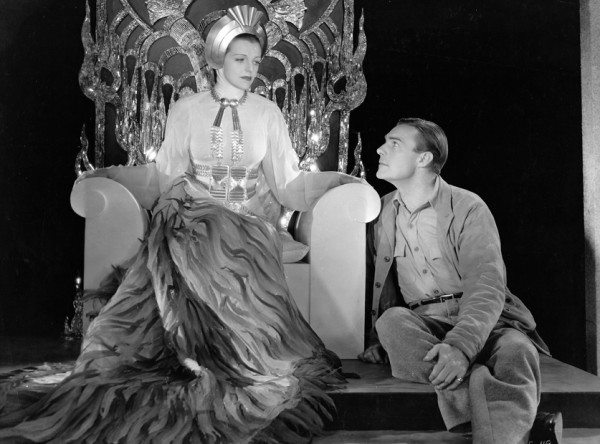
Helen Mack was "Tanya
Dugmore" a character not in the original novel. Although Mack had been
acting since the age of 10. She is known to fans of adventure films as
"Hilda", the girl in distress, in Merian C. Cooper's 1933 "Son
of Kong". Along with Cooper's same year "Blind
Adventure" with her "Kong, Junior", co-star Robert
Armstrong, Roland Young and Ralph Bellamy.
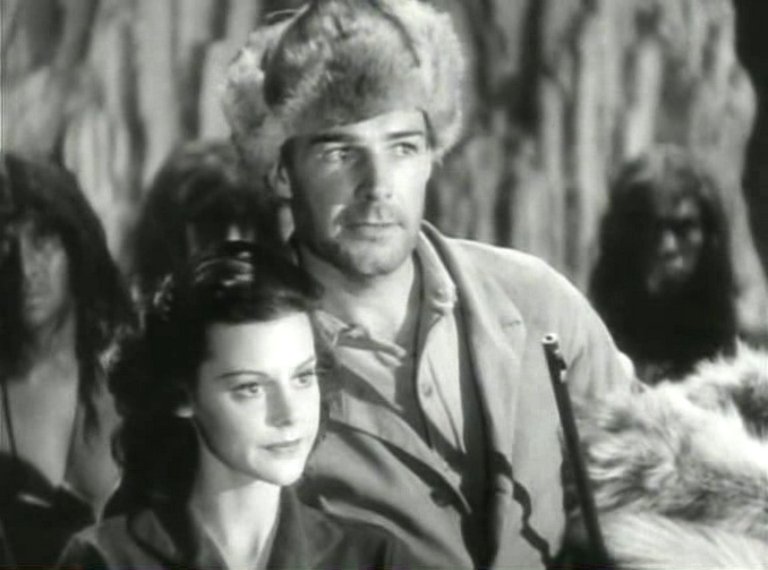
The fourth actor was Nigel Bruce as
"Professor Horace Holly". Although this film was four years
prior to Bruce teaming up with Basil Rathbone in "The Hound
of the Baskervilles". There is no question that he modeled
"Dr. Watson" after "Holly"._09.jpg)
_09.jpg)
The screenplay by the team of Dudley
Nichols and Ruth Rose. Rose wrote the screenplay for 1933's "King Kong", she moved the location from Africa to Arctic Siberia. Ruth Rose actually took elements from all four novels about "Ayesha". These
are "She: A History of Adventure", "She and
Allan", in which "Ayesha" meets "Allan
Quatermain", "Ayesha: the Return of SHE" and "Wisdom's
Daughter".
The original motion picture was released in black and white, but was colorized under the direction of Stop Motion Animator Ray Harryhausen.
The original motion picture was released in black and white, but was colorized under the direction of Stop Motion Animator Ray Harryhausen.
A Brief Overview of the Screenplay:
Ruth Rose moved the location of the "City of Kor", from Africa to the Serbian Arctic.
Ruth Rose's Basic Story (Spoilers Included):
"Leo Vincey" has been called back to England, from Canada, to his families ancestral estate by his dying uncle, "John Vincey", portrayed by Samuel Hinds. There he meets his uncle's best friend, "Horace Holly". Those two men tell "Leo" a fantastic story about his ancestor, also named "Leo Vincey", who led an expedition, accompanied by his wife, into the Siberian Arctic and discovered the "Fountain of Youth". "Leo's" ancestors expedition took place 500-years ago, and only that "Leo Vincey's" wife returned, but with his journal. After which she never told anyone what had happened to her husband.
This "Leo" is shown a portrait of the other "Leo", and is amazed at the resemblance. Before his uncle dies that same night, his ancestors journal is given to this "Leo", and accompanied by "Holly", the two set out to find the "Fountain of Youth" and what happened to his ancestor.
Following the directions in his ancestor's journal, "Leo" and "Holly" travel to the Serbian Arctic in search of the truth, if any, in the journals strange tale. There they meet a guide named "Dugmore",
played by Lumsden Hare, who believes they have a map to a legendary treasure. "Leo" and "Holly" also meet "Dugmore's" mistreated, almost as a slave, daughter, "Tanya".
With porters at the start of their journey, the four set out to climb the mountain that is alleged to contain "The Fountain of Youth".
The porters desert and the four come across a saber tooth tiger frozen in the ice.

"Dugmore" will be killed by falling off an ice shelf, leaving "Leo", "Holly" and "Tanya" to go on, but as they progress up the mountain, "Leo" becomes deathly ill.

With "Leo" seemingly close to death, the three come across a strange ancient race, the "Amahaggar", and are taken into the outer part of "Legendary City of Kor".
The "Amahaggar" were once cannibals, but have been forced to stop the practice by order of "Ayesha, She Who Must Be Obeyed". However, they revert back to the practice upon finding the three "White" travelers.
On the order of the "Amahaggar Chief", portrayed by Noble Johnson, "Holly" is about to have a red hot headpiece placed over his head and onto his shoulders.
_10.jpg)
When horns blare, and every action of the "Amahaggar" seems to freeze in place. "Holly" and "Tanya" stare in amazement at "Ayesha", who upon seeing "Leo", lets out a scream. She is looking upon her lover, "Kallikrates", from 500-years ago, and instructs her high priest "Billali", portrayed by Gustav von Seyffertitz, to get the three strangers quarters and medical care for her "Kallikrates, Leo Vincey", who has returned to her.
"Tanya" begs "Ayesha" to let her nurse "Leo" back to health and she is permitted, but the ruler of "Kor" recognizes a rival that must be taken care of.
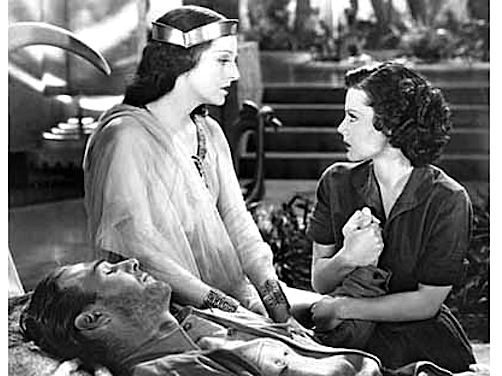
After "Leo" recovers, along with "Holly" and "Tanya", the three are called to witness the wrath of "SHE Who Must Be Obeyed!".
"SHE" orders the executions, including their chief, of several of the "Amahaggar" men for reverting back to cannibalism. These executions are over "Leo's" objections, but "SHE" says this is necessary for "Ayesha" to remain in power by causing fear in her subjects.

_12.jpg)
Later, after the execution, "Ayesha" shows this "Leo" the body of "Kallikrates". Which she has kept preserved until his returned to her once more. "Leo" stares at his own face in disbelief.
"Ayesha" claims she murdered his ancestor in a fit of jealous rage over his wife. "Leo" says that's impossible, because it would have to have happened 500-years ago. "Ayesha" takes him to where the "Pillar of Fire" is and explains that when it turns "Blue and Cold", you enter and never age. "Leo Vincey" realizes he's staring at the mythical, "Fountain of Youth", that he and his ancestor was searching for.
"Ayesha" now moves on "Tanya", who is obviously in love with "Leo", and arranges to have her sacrificed as both"Leo" and "Holly" unknowingly watch. Initially, the gagged and veiled "Tanya" is brought to the same place the "Amahaggar" were executed.

"Ayesha's" plan of course does not work and "Leo" rescues "Tanya".
"Leo" takes "Holly" to see the "Pillar of Fire", "Ayesha" arrives and attempts to have her reborn "Kallikrates" to join her in eternal life by entering the flame when it turns cold. To prove entering is safe "Ayesha" enters the flame and ages 2,000 years, because you can only enter the flame once!


At the same moment, the "Amahaggar" start a revolt and a battle against the once "She, Who Must Be Obeyed's" soldiers takes place. As "Leo" and "Holly" locate "Tanya" and fight their way out of "The Lost City of Kor", and start back to their civilization.
If my reader is wondering about the
impact of this picture had on its audience. One of those who saw it several
times was a young animator named Walt Disney. When the first full length
animated cartoon "Snow White and the Seven Dwarfs" premiered
three years after Merian C, Cooper's "SHE". It was
obvious that Walt was still remembering this feature.
Above the "Wicked Queen", and below, Helen Gashagan as
"Ayesha". Walt
admitted the inspiration for the Queen. When Stop Motion Animator Ray
Harryhausen supervised Cooper's "SHE" to be
colorized. He chose Disney's color for "Ayesha's" clothing.
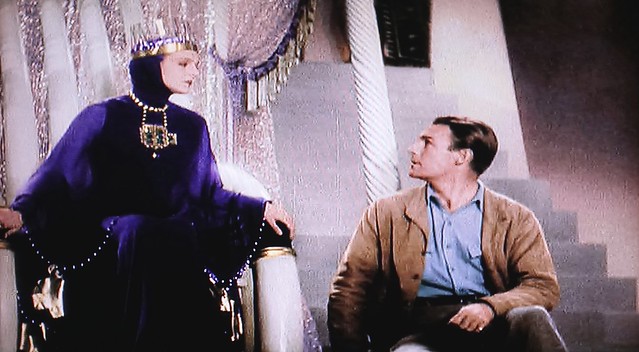
It would be thirty years before
another motion picture based upon the H. Rider Haggard novel came to the motion
picture screen. Hammer Films "SHE" premiered on
April 18, 1965 in the UK and on June 9, 1965 in the United States and was a
major box office success.
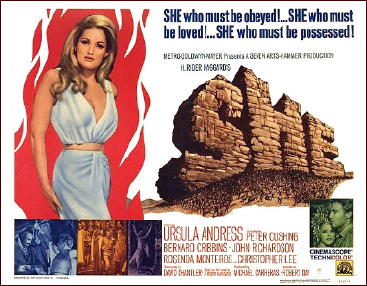

Ursula Andress was "Ayesha". This was Andress' ninth motion
picture. Three of her four proceeding motion pictures had made the actress an
international star. They were 1962's "Dr. No" the
first "James Bond" motion picture, 1963's "Fun in
Acapulco" starring Elvis Presley and 1963's "4 For
Texas" starring Frank Sinatra and Dean Martin. Right before this
film Ursula Andress starred with her then husband actor John Derek in 1965's "Nightmare
in the Sun" and would follow "SHE" with
1965's "What's New Pussycat" starring Peter Sellers. It just be noted that in both "Dr. No" and "SHE" the voice you hear is not Ursula Andress as her Swiss-German accent was too thick and German voice over actress Nikki van der Zyl is who you heard.

Peter Cushing was "Holly". Hammer Horror star Peter Cushing's previous two films were 1964' s "The Gorgon" and 1965's "Dr. Terror's House of Horrors". He would follow "SHE" with the controversial motion picture 1965's "Dr. Who and the Daleks".

Bernard Cribbens was "Job". Cribbens was a popular UK dramatic and comedy actor. He was part of the "Carry On" gang is a very popular British motion picture series on both sides of the Atlantic. He had been seen in a parody of the Space Race 1963's "The Mouse on the Moon". In `1966 Cribbens was in the Peter Cushing "Daleks' Earth Invasion 2150 A.D." and would be seen with David Tennant as "Donna's father", "Wilfred Mott", in "Dr. Who" from 2007 to 2010 off and on.

John Richardson was "Leo Vincey". Ricardson's first six film were small non on screen credited roles. Then in 1960 he portrayed "Dr. Andrej Gorobec" in Maria Bava's classic "La Maschera Del Domonio (The Mask of Satan)" aka: "Black Sunday" co-starring Barbara Steele and back to non on screen credited roles until "SHE". John Richardson followed this picture co-starring with Raquel Welch in Ray Harryhausen's 1966 "One Million Years B.C.".

Rosenda Monteros was "Ustane". Mexican actress Rosenda Monteros made her English language debut in John Sturges' 1960 "The Magnificent Seven" as "Petra". Six Mexican films later came "SHE" and the following year was in the excellent "Savage Pampas" made in Argentina and starring American Robert Taylor.

Peter Cushing was "Holly". Hammer Horror star Peter Cushing's previous two films were 1964' s "The Gorgon" and 1965's "Dr. Terror's House of Horrors". He would follow "SHE" with the controversial motion picture 1965's "Dr. Who and the Daleks".

Bernard Cribbens was "Job". Cribbens was a popular UK dramatic and comedy actor. He was part of the "Carry On" gang is a very popular British motion picture series on both sides of the Atlantic. He had been seen in a parody of the Space Race 1963's "The Mouse on the Moon". In `1966 Cribbens was in the Peter Cushing "Daleks' Earth Invasion 2150 A.D." and would be seen with David Tennant as "Donna's father", "Wilfred Mott", in "Dr. Who" from 2007 to 2010 off and on.

John Richardson was "Leo Vincey". Ricardson's first six film were small non on screen credited roles. Then in 1960 he portrayed "Dr. Andrej Gorobec" in Maria Bava's classic "La Maschera Del Domonio (The Mask of Satan)" aka: "Black Sunday" co-starring Barbara Steele and back to non on screen credited roles until "SHE". John Richardson followed this picture co-starring with Raquel Welch in Ray Harryhausen's 1966 "One Million Years B.C.".

Rosenda Monteros was "Ustane". Mexican actress Rosenda Monteros made her English language debut in John Sturges' 1960 "The Magnificent Seven" as "Petra". Six Mexican films later came "SHE" and the following year was in the excellent "Savage Pampas" made in Argentina and starring American Robert Taylor.
Christopher Lee was Billali". Lee's four previous motion pictures in 1964 were the Italian "La cripta e l'incubo (The Crypt and the
Nightmare)" and "Il castello del morti (The Castle of the Dead)",, Hammer's "The Devil-Ship
Pirates" and "The Gorgon".
Christopher Lee made several motion pictures in Italy, Germany and Spain fluently speaking the language. My article on these films can be found at:
http://www.bewaretheblog.com/2016/08/christopher-lee-foreign-language-motion.html

World War One has ended and honorably discharged "Leo Vincey", "Professor Horace Holly" and their orderly "Job" are sitting in a Palestine restaurant deciding on what to do next. "Leo" tells the others he has been having dreams about a mysterious women.

"Leo" later meets "Ustane" an outcast from a city across the desert in the "Mountains of the Moon". That night it seems the mysterious dream women visits "Leo" and promises him wealth and power, if he will only come with her now. He declines, but she gives him a map, a ring and leaves without saying another word.

"Professor Holly" identifies the ring as an Egyptian relic at least 2,000 years old and that the map speaks to the location of the lost city of Kuma in the "Mountains of the Moon". "Leo" asks "Ustane" to guide the three friends and she agrees, because she is falling in love with him, but is also afraid of going back to Kuma.

Christopher Lee made several motion pictures in Italy, Germany and Spain fluently speaking the language. My article on these films can be found at:
http://www.bewaretheblog.com/2016/08/christopher-lee-foreign-language-motion.html

World War One has ended and honorably discharged "Leo Vincey", "Professor Horace Holly" and their orderly "Job" are sitting in a Palestine restaurant deciding on what to do next. "Leo" tells the others he has been having dreams about a mysterious women.

"Leo" later meets "Ustane" an outcast from a city across the desert in the "Mountains of the Moon". That night it seems the mysterious dream women visits "Leo" and promises him wealth and power, if he will only come with her now. He declines, but she gives him a map, a ring and leaves without saying another word.

"Professor Holly" identifies the ring as an Egyptian relic at least 2,000 years old and that the map speaks to the location of the lost city of Kuma in the "Mountains of the Moon". "Leo" asks "Ustane" to guide the three friends and she agrees, because she is falling in love with him, but is also afraid of going back to Kuma.

By the time the group arrives at the entrance to Kuma "Leo" is
feverish. They start to enter and meet the "Amahaggar" who, because
they're all White, decide to sacrifice them.

Above far left is Andre Morrell as "Ustane's" father "Haumeid". Morrell was "Dr. Watson" to Peter Cushing's "Sherlock Holmes" in Hammer's "The Hound of the Baskervilles".
"Billali" arrives and stops the sacrifice and will take the adventures to the palace. "Ustane" asks to come along and care for "Leo". The group is brought before "Ayesha" and she cautiously lets "Ustane" care for "Leo", but recognizes a rival for his love.
With "Leo's" fever cured "Leo", "Holly" and "Job" witness the vengeance of "She Who Must Be Obeyed" against the "Amahaggar". As a group of men are thrown into a lava pit.


"Ayesha" shows "Holly", "Leo" and "Job" the remains of the original Egyptian city of Kuma and talks as if she actually walked those streets. At this point they do not know she is 2,000 years old.

Above far left is Andre Morrell as "Ustane's" father "Haumeid". Morrell was "Dr. Watson" to Peter Cushing's "Sherlock Holmes" in Hammer's "The Hound of the Baskervilles".
"Billali" arrives and stops the sacrifice and will take the adventures to the palace. "Ustane" asks to come along and care for "Leo". The group is brought before "Ayesha" and she cautiously lets "Ustane" care for "Leo", but recognizes a rival for his love.
With "Leo's" fever cured "Leo", "Holly" and "Job" witness the vengeance of "She Who Must Be Obeyed" against the "Amahaggar". As a group of men are thrown into a lava pit.


"Ayesha" shows "Holly", "Leo" and "Job" the remains of the original Egyptian city of Kuma and talks as if she actually walked those streets. At this point they do not know she is 2,000 years old.

A major difference from the 1935 version is that Christopher Lee's "Billali" is the High Priest. Who believes, for his service, he dissevers immortality. With the arrival of "Leo", the reincarnation of "Kallikrates", 'Billali's" plans are threatened and he must find away to get rid of he other and he realizes that the key to getting at "Leo" is "Ustane".

He stokes "Ayesha's" jealousy. This will lead to the young women's execution. Followed by a revolt, led by her father, of the "Amahaggar". "Haumied" is killed along with others.


At the climax "Billali" follows "Ayesha" and "Leo" to the secret "Pillar of Fire". "Billali" reveals himself and attempt to both kill "Leo" and enter the flames, but is killed himself.


As "Holly" and "Job" arrive/ They watch as "Ayesha" enters the flames and calls for "Leo" to join her. With a twist from the original H. Rider Haggard novel "Leo" joins her. Then as in the novel "Ayesha" ages before the reincarnated "Kallikrates".

Continuing the twist the film ends with "Leo" now immortal and waiting for perhaps another 2,000 years to end his life. He bids good-bye to "Holly" and "Job" and becomes the new ruler of the lost city of Kuma.
Hammer Studios couldn't let a good idea die and three years later on April 14, 1968 in the UK and May 1, 1968 in the United States was "The Vengeance of She".

John Richardson is back as "Kallikrates" ruling Kuma in 1968.
Olgas Schoberova, using the name Olga Berova, was a
Czechoslovakian actress, with a total career of 22 films, who portrayed
"Carol". "Carol" is possessed by the spirit of "Ayesha"
wanting to return to her love in Kuma.


Edward Judd portrayed "Phillip". Who helps
"Carol" reach Kuma and falls in love with her. Judd had been seen in
1961's "The Day the Earth Caught Fire", Ray
Harryhausen's 1964 "First Men in the Moon" and
1966's "Island of Terror" with Peter Cushing.


Basically we have a reworking of the original picture and the
question will "Phillip" be able to stop the spirit of
"Ayesha" and block "Kallikrates" from taking
"Carol-Ayesha" into the "Pillar of Fire"? The
screenplay takes too long getting to Kuma.



Above Olinka Berova doing her best Ursula Andress. Below
Richardson and Berova at the "Pillar of Fire".


In the end the already damaged "Statue of Ayesha" falls
into the "Pillar of Fire", meteorically releasing her hold on
"Carol", and "Kallikrates" enters the Blue Flame and ages
turning to dust. "Carol" and "Phillip" walk away from Kuma.
"The Vengeance of She" has, as of this writing, never made back its costs, but was
far better than the low budget 1984, or according to some perhaps made in 1982 and shelved because of how bad the picture was.
This "SHE" was first released to movie theaters
on May 15, 1984 in Columbia, South America and made it to the UK in July 1985
straight to Beta Tape and the United States later that year straight to VHS
Tape.
Sandahl Bergman,"Valeria" in 1982's "Conan the Barbarian". was "SHE". No other name is given to the character. The film was the third directed by future Award Winning Israeli Avi Nesher. Nesher also wrote the screenplay and stated it was "Inspired" by H. Rider Haggard's novel.
The story takes place in a post-apocalyptic world, think "The Road Warrior" meets "Red Sonya", 23 years after a nuclear holocaust. As two brothers search for their sister. The two are helped by "SHE" and her female warriors.
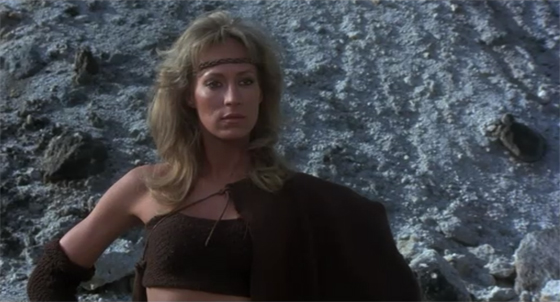
Sandahl Bergman,"Valeria" in 1982's "Conan the Barbarian". was "SHE". No other name is given to the character. The film was the third directed by future Award Winning Israeli Avi Nesher. Nesher also wrote the screenplay and stated it was "Inspired" by H. Rider Haggard's novel.
The story takes place in a post-apocalyptic world, think "The Road Warrior" meets "Red Sonya", 23 years after a nuclear holocaust. As two brothers search for their sister. The two are helped by "SHE" and her female warriors.


The last version to date also went straight to UK video in 2001 and I could find very little, but it appears to be a South African and Germany co-production. Although some sites mention Canada.
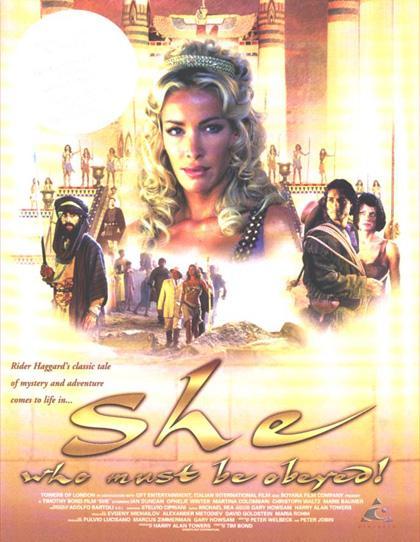
The basic story has "Leo Vincey", Ian Duncan, receiving a map from his late father telling how to reach the legendary city of Kor. Accompanied by his girlfriend "Roxanne", Marie Baumer, they find the city ruled by a Queen named "Ayesha", Ophelle Winter. "Leo" learns that 2,000 years ago "Killikrates" an Egyptian priest was murdered by a Princess. He is told that he is the reincarnation of that priest and that "Ayesha" is that Princess. "Leo" and "Roxanne" have to fight off attacks by people wanting to kill them and find away from Kor, before "Ayesha" can kill him once again out of love.
KING SOLOMON'S MINES the Novel
The novel "King Solomon's Mines' was first published in September 1885 and became a major worldwide success. As I mentioned it was the start of the "Lost World Literary Genre".
"Allan Quatermain" is an well known adventurer and "White Hunter" in Durban, South Africa. "Quatermain" should have retired years ago, but his wife died and he needs money for his son "Harry's" schooling. In the novel "Allan" is approached by two men "Sir Henry Curtis" and "Captain Good". They ask him to lead a safari to find "Sir Henry's" missing brother in the uncharted area of Northern Africa. "Sir Henry's" brother went on the fool's quest to find the legendary diamond mines of "King Solomon".
It happens that "Allan" has a map that is suppose to show the way to the mines, but has never taken the story seriously.
The three leave for the uncharted North of Africa following the map. Joining their group is a mysterious African native named "Umbopa" who acts like he is more than just a porter.
The novel tells of their adventures traveling to the mountains known as the "Breasts of Sheba". They eventually meet a tribe of natives, somewhat like the Zulu called the "Kukuana", that capture the four men. Two things immediately happen. The first results from "Captain Good" fixing his false teeth and frightening the natives into thinking he is a God. The second is "Umbopa" reveals something on his chest and the natives, lead by a man named "Ignosi" bow to him.
"Quatermain", "Curtis" and "Good" have been traveling with the rightful King of the "Kukuana's", but do not know this until later. Some of the natives leave and the others take the adventures to the Kraal of the ruthless "King Twala". Where they also meet the very ancient and evil Witch "Gagool". She remembers the murder of "Umbopa's" father and his mother disappearing with their son. The cunning "Gagool" has always expected his return and now must find a way of eliminating "Umbopa" to keep her puppet "Twala" as the "King".
"Quatermain", "Curtis" and "Good" have been traveling with the rightful King of the "Kukuana's", but do not know this until later. Some of the natives leave and the others take the adventures to the Kraal of the ruthless "King Twala". Where they also meet the very ancient and evil Witch "Gagool". She remembers the murder of "Umbopa's" father and his mother disappearing with their son. The cunning "Gagool" has always expected his return and now must find a way of eliminating "Umbopa" to keep her puppet "Twala" as the "King".
This all will lead to a civil war, the defeat of "Twala" and "Umbopa" being put on the throne. "Gagool" will attempt to murder "Quatermain", "Curtis" and "Good" after showing them to "King Solomon's Mines"and sealing them in. They find the body of "Henry Curtis'" brother. However, a young "Kukuana" women who became attached to "Captain Good", after nursing his wounds from the battle to overthrow "Twala", kills "Gagool".
The story ends with the three having been trapped in the mines by "Gagool", being rescued and leaving with some diamonds and returning to Durban.
KING SOLOMON MINES the Motion Pictures
The first motion picture version of the novel is considered the best. Although it made one major change to the story. This film was from the :Gaumont British Picture Corporation" and was released in the UK on June 17, 1937 and the United States on July 26, 1937.


As the above poster indicates the major change to the novel was adding a women and love story. Otherwise this is still the most faithful adaptation to H. Rider Haggard's novel.
Screenplay writer Charles Bennett's name is associated with this motion picture. Bennett wrote the screenplays for Alfred Hitchcock's 1934 "The Man Who Knew Too Much", 1935's "The 39 Steps", 1936's "Secret Agent" and "Sabotage". Bennett would also write Hitch's 1940 "Foreign Correspondent". However, Charles Bennett in several interviews over the years said he took himself off the project, because he thought it was a silly idea adding a women to the story.
The actual screenplay was the third by actor turned screenwriter Michael Hogan with additional dialogue by playwright Roland Pertwee.
Even with the adding of a women the cast of this film was impressive for the time.
Sir Cedric Hardwicke was "Allan Quartermain" (Note the spelling change). The actor had been seen in the only motion picture written by H.G. Wells 1936's "Things to Come" and in 1939 would be seen in three classic motion pictures. They were "Stanley and Livingston" with Spencer Tracy, "On Borrowed Time" with Lionel Barrymore and "The Hunchback of Notre Dame" starring Charles Laughton and introducing Maureen O'Hara.


I always thought Hardwicke looked like a "White Hunter" and a man who could tackle any obstacle placed in his path in Africa. As compared to the Hollywood Leading men of the following versions.
Anna Lee portrayed the created character of "Kathy O'Brien". Lee had become a major heroine in British films by this time. She had just been opposite Boris Karloff in 1936 "The Man Who Lived Again" and in 1946 would again co-star with the Horror actor is Val Lewton's "Bedlam". In 1940 she co-starred with Marlene Dietrich and John Wayne in "Seven Sinners" and would be part of director John Ford's ensemble cast in 1941's "How Green Was My Valley".


Paul Robeson was "Umbopa". African American singer and actor Paul Robeson had been seen on Broadway in Jerome Kern's and Oscar Hammerstein II's "Show Boat" as "Joe". He reprized the role in James Whale's 1936 motion picture and was known worldwide for his definitive rendition of "Ol' Man River". In this film he would sing some African based songs as the group treks to the "Kukuana Country".
At the start of the 1950's Civil Rights activist Robeson would be caught up in the "House Committee on Un-American Activities" and become "Black Listed". At which time he returned to the UK. His life story and a look at race in America may be read on my blog at:
At the start of the 1950's Civil Rights activist Robeson would be caught up in the "House Committee on Un-American Activities" and become "Black Listed". At which time he returned to the UK. His life story and a look at race in America may be read on my blog at:
Roland Young portrayed "Commander Good". Young was "Dr. Watson" to John Barrymore's "Sherlock Holmes" in 1922. He had been in director George Cukor's 1935 "David Copperfield" and in 1936 he was H.G. Wells' "The Man Who Could Work Miracles". Roland Young would follow "King Solomon's Mines" later in 1937 as "Topper" in the first of a series of comedy motion pictures about a man haunted by the ghosts of his best friends.
Below Roland Young and Sir Cedric Hardwicke.
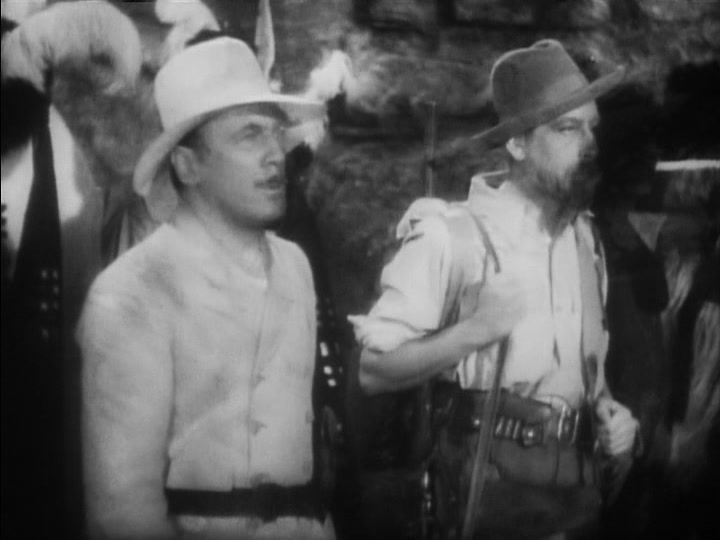

John Loder was "Sir Henry Curtis". Loder was a solid "B" British leading man that early in his career appeared in German movies. He was Anna Lee's leading man in Boris Karloff's 1936 "The Man Who Lived Again", he had fifth billing in Alfred Hitchcock's 1936 "Sabotage" written by Charles Bennett. Loder was the man in love with Margaret Lockwood in 1937's "Dr. Syn" starring George Arliss as the famous British pirate/smuggler "Captain Clegg". In 1941 he joined Anna Lee in the ensemble cast of director John Ford's "How Green Was My Valley".
In 1882 "Patrick 'Patsy' O'Brien"has been chasing dreams of diamonds in Kimberley, South Africa. He has not found his fortune.
He persuades "Allan Quartermain" to give him and his daughter "Kathy" a lift in his ox cart to the coast. Along the way they find two men dying in another cart. One is a native name "Umbopa" who recovers and the other "Silvestra", played by Arthur Goullet, dies, but not before claiming he has a map to "King Solomon's Mines".
He persuades "Allan Quartermain" to give him and his daughter "Kathy" a lift in his ox cart to the coast. Along the way they find two men dying in another cart. One is a native name "Umbopa" who recovers and the other "Silvestra", played by Arthur Goullet, dies, but not before claiming he has a map to "King Solomon's Mines".
During the night "Patsy" sneaks off with the map. "Kathy" attempts to get "Allan" to follow her father, but he refuses, because he is to meet with new clients "Sir Henry Curtis" and ex-Navy "Commander Good". At her first chance "Kathy" steals the wagon and the three men joined by "Umbopa" set off after her. Once they catch up it is decided to help "Kathy" find her father and the quest for "King Solomon's Mines" is on and the start of a romance.

At one point the porters abandoned them out of fear. However, "Umbopa" wants to stay and they set off across the desert toward the "Breasts of Sheba".
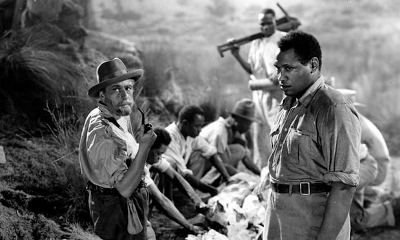
They cross the mountains and are captured by a group of natives and taken to the kraal of their despot King "Twala", portrayed by Robert Adams. The natives are afraid of "Good", because he is in his night shirt and has white legs. "Good" is forced to initially stay that way.

"Twala" takes them to the entrance to the mines guarded by the witch doctor "Gagool" played by 65 year old actress Sydney Fairbrother. "Twala" tempts the group by showing them the interior of the mines. They are returned to the kraal and the guarded hut awaiting whatever fate he has for them.
That night "Umbopa" reveals that he is the rightful king and they meet with "Infadoos", portrayed by Ecce Homo Toto, and a plan to revolt against "Twala's" cruel rule is put together. It will be up to "Quartermain" and the others to find something to make the "Kukana's" further believe they are gods. "Good" discovers there is to be an eclipse the following day at 11:15 AM, if the group can stall until it happens.
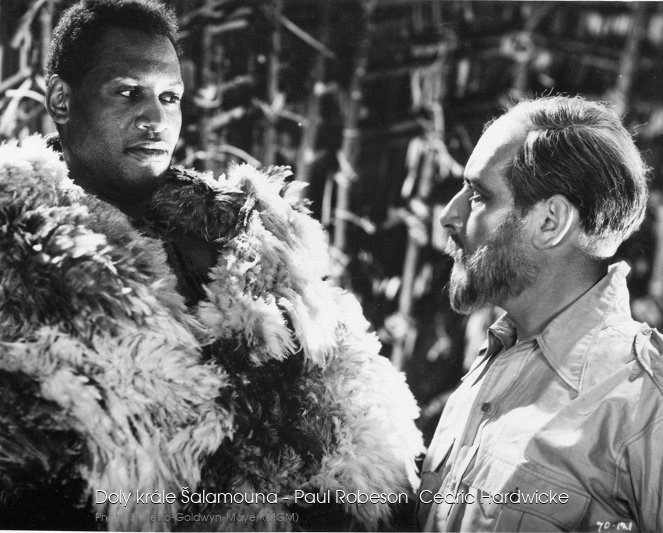
That night "Umbopa" reveals that he is the rightful king and they meet with "Infadoos", portrayed by Ecce Homo Toto, and a plan to revolt against "Twala's" cruel rule is put together. It will be up to "Quartermain" and the others to find something to make the "Kukana's" further believe they are gods. "Good" discovers there is to be an eclipse the following day at 11:15 AM, if the group can stall until it happens.

The following day "Gagool" conducts "smelling out of evil doers", or the means of "Twala" removing anyone who might stand in his way. "Gagool" has several natives killed and then as "Gagool", who recognized "Umbopa" for what he is, approaches him."Quartermain" stops her by predicting the disappearance of the sun. It works, "Umbopa" reveals himself as the rightful King and the revolt starts.
During the battle between "Twala's" forces and "Umbopa's". "Sir Henry Curtis" kills "Twala" ending the war and "Twala's" natives pledge alliance to "Umbopa".

While the battle was raging "Kathy" slipped away, entered the mines and found her father with a broken leg and a pouch full of diamonds. She goes to the others for help. "Allan", "Sir Henry" and "Good" leave "Umbopa" with his tribe and enter the mine. While they are doing this "Gagool" causes a rock slide sealing them to their doom.

What "Gagool" doesn't see was "Umbopa" and some of the natives following her to "King Solomon's Mines" and witness the witch doctor being killed by her own rock slide. Those within the mine are rescued and at the film's end leave the "Kukuana's" and their friend "Umbopa".

While the battle was raging "Kathy" slipped away, entered the mines and found her father with a broken leg and a pouch full of diamonds. She goes to the others for help. "Allan", "Sir Henry" and "Good" leave "Umbopa" with his tribe and enter the mine. While they are doing this "Gagool" causes a rock slide sealing them to their doom.

What "Gagool" doesn't see was "Umbopa" and some of the natives following her to "King Solomon's Mines" and witness the witch doctor being killed by her own rock slide. Those within the mine are rescued and at the film's end leave the "Kukuana's" and their friend "Umbopa".
Thirteen years later on November 9, 1950 Metro-Goldwyn-Mayer (MGM) released their version of "King Solomon's Mines". Which is often referred too as the definitive motion picture, but this is a typical Hollywood production of the period. Rather than what H. Rider Haggard wrote in his novel.
The screenplay was by Helen Deutsch. The playwright made a name for herself with 1944's "The Seventh Cross" staring Spencer Tracey. The hard hitting picture was about Nazi's hunting down and executing seven escaped prisoners, but her Hollywood writing turned toward romance films with strong female leads. Her work included 1944's "National Velvet" starring a young Elizabeth Taylor, 1947's "Golden Earrings" starring Marlene Dietrich, 1948's "The Loves of Carmen" starring Rita Hayworth and after this picture. There were two films starring Leslie Caron 1953's "Lili" and 1955's "The Glass Slipper".
So it was no wonder that Helen Deutsch's screenplay for "King's Solomon's Mines" had the major character a women and a secondary romantic love story. Deutsch also changed characters names and made "Umbopa" a minor character described at a "Tall Prince in exile" in the screenplay.. Helen Deutsch also down played, or removed other elements of the novel completely.
Devorah Kerr portrayed "Elizabeth Curtis". There is no "Sir Henry Curtis" and she is not "Lady Elizabeth Curtis". The Scottish Kerr was still considered a British actress and had appeared in 14 films prior to this American made motion picture. She would follow "King Solomon's Mines" opposite Robert Taylor in 1951's religious epic, from MGM, "Quo Vadis", the studios 1952 remake of "The Prisoner of Zenda", MGM's 1953 version of William Shakespeare's "Julius Caesar" starring Marlon Brando and James Mason and the same year star opposite Burt Lancaster in "From Here to Eternity". The pre-World War 2 film set at Pearl Harbor in which Frank Sinatra received the Best Supporting Actor Oscar.
/_4by3/_derived_jpg_q90_600x800_m0/KingSolomonsMines1950-Still6.jpg?partner=allmovie_soap)
Stewart Granger was "Allan Quatermain", At least they had the name spelled right. While Deborah Kerr would do Shakespeare's "Julius Caesar", Stewart Granger had done George Bernard Shaw's "Julius Caesar" with third billing behind Claude Rains and Vivian Leigh in 1945's "Caesar and Cleopatra". So far he had been opera composer Nicola Paganini in 1946's "The Magic Bow", 1947's "Captain Boycott" as Irishman Hugh Davin the source of the word "Boycott" and would follow "King Solomon's Mines" with 1951's "Soldiers Three". A reworking of the 1939 "Gunga Din" and in 1952 would re-team with Kerr for "The Prisoner of Zenda".
/_derived_jpg_q90_600x800_m0/KingSolomonsMines1950-Still7.jpg?partner=allmovie_soap)
So it was no wonder that Helen Deutsch's screenplay for "King's Solomon's Mines" had the major character a women and a secondary romantic love story. Deutsch also changed characters names and made "Umbopa" a minor character described at a "Tall Prince in exile" in the screenplay.. Helen Deutsch also down played, or removed other elements of the novel completely.
Devorah Kerr portrayed "Elizabeth Curtis". There is no "Sir Henry Curtis" and she is not "Lady Elizabeth Curtis". The Scottish Kerr was still considered a British actress and had appeared in 14 films prior to this American made motion picture. She would follow "King Solomon's Mines" opposite Robert Taylor in 1951's religious epic, from MGM, "Quo Vadis", the studios 1952 remake of "The Prisoner of Zenda", MGM's 1953 version of William Shakespeare's "Julius Caesar" starring Marlon Brando and James Mason and the same year star opposite Burt Lancaster in "From Here to Eternity". The pre-World War 2 film set at Pearl Harbor in which Frank Sinatra received the Best Supporting Actor Oscar.
/_4by3/_derived_jpg_q90_600x800_m0/KingSolomonsMines1950-Still6.jpg?partner=allmovie_soap)
Stewart Granger was "Allan Quatermain", At least they had the name spelled right. While Deborah Kerr would do Shakespeare's "Julius Caesar", Stewart Granger had done George Bernard Shaw's "Julius Caesar" with third billing behind Claude Rains and Vivian Leigh in 1945's "Caesar and Cleopatra". So far he had been opera composer Nicola Paganini in 1946's "The Magic Bow", 1947's "Captain Boycott" as Irishman Hugh Davin the source of the word "Boycott" and would follow "King Solomon's Mines" with 1951's "Soldiers Three". A reworking of the 1939 "Gunga Din" and in 1952 would re-team with Kerr for "The Prisoner of Zenda".
/_derived_jpg_q90_600x800_m0/KingSolomonsMines1950-Still7.jpg?partner=allmovie_soap)
Richard Carlson was "John Goode", note the misspelling, now the brother of "Elizabeth Curtis". Richard Carlson had appeared in motion pictures since 1935. He was a solid supporting actor and three years after this film, in 1953, would appear in the first of Ivan Tors' "Office of Scientific Investigation" series "The Magnetic Monster". Followed in the same year by the 3-D Science Fiction Classic "It, Came from Outer Space" and another 1953 3-D feature "The Maze".
My article on the life and career of the Academic that became an actor Richard Carlson may be read at:
My article on the life and career of the Academic that became an actor Richard Carlson may be read at:
http://www.bewaretheblog.com/2015/08/richard-carlson-academic-turned-actor.html

Above left to right Richard Carlson, Deborah Kerr and Stewart Granger.
"Elizabeth Curtis" goes to "Allan Quatermain" to help find her missing husband and he refuses her for two reasons. The first he never takes a women on safari and the second, because her husband went after the legendary "King Solomon's Mines".
Her brother "John Goode" then goes to "Quatermain" to argue her case. Reluctantly "Allan" takes on the safari, because he is offered needed money to keep his son "Harry" in school in England.

The three set off following a copy of a map her husband left "Elizabeth".

The safari is being followed by a lone native and eventually they meet "Umbopa" portrayed by Siraque.
"Allan Quatermain" at every opportunity has made it known to "Elizabeth Curtis" that he has no use for a women on safari. However, things become complicated as the two are falling in love.

"Goode" has made it known to "Quatermain" that "Elizabeth's" husband treated her badly and was really after her wealth. He drops the hint that she may really be looking for her husband to determine, if he's still alive. Although she won't admit it to anyone and especially herself.

Above left to right Richard Carlson, Deborah Kerr and Stewart Granger.
"Elizabeth Curtis" goes to "Allan Quatermain" to help find her missing husband and he refuses her for two reasons. The first he never takes a women on safari and the second, because her husband went after the legendary "King Solomon's Mines".
Her brother "John Goode" then goes to "Quatermain" to argue her case. Reluctantly "Allan" takes on the safari, because he is offered needed money to keep his son "Harry" in school in England.

The three set off following a copy of a map her husband left "Elizabeth".

The safari is being followed by a lone native and eventually they meet "Umbopa" portrayed by Siraque.
"Allan Quatermain" at every opportunity has made it known to "Elizabeth Curtis" that he has no use for a women on safari. However, things become complicated as the two are falling in love.

"Goode" has made it known to "Quatermain" that "Elizabeth's" husband treated her badly and was really after her wealth. He drops the hint that she may really be looking for her husband to determine, if he's still alive. Although she won't admit it to anyone and especially herself.
The safari encounters a man called "Smith" in a native village, but "Allan" realizes he is a wanted criminal named "Van Brun" portrayed by Hugo Haas.

"Vam Brun" can't let them leave after being identified. There is a confrontation and "Quatermain's" long time friend and leader of the porters "Khiva" is killed along with "Van Brun". They are able to escape the angry natives that were protecting the criminal.

Immediately upon reaching the region the map indicates is the location of the mines. "Allan", "Elizabeth", "John" and "Umbopa" are met by natives. At this point the other three discover they have been traveling with royalty in exile returning to claim his throne. "Umbopa" reveals to the native the markings on his chest and the word goes out that the rightful "King" has returned.
The three searchers are escorted to the kraal of "King Twala", played by Baziga, a despot leader. While "Umbopa" goes another way with some of the other natives they have just met.
/_derived_jpg_q90_600x800_m0/KingSolomonsMines1950-Still8.jpg?partner=allmovie_soap)
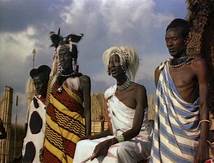
There they meet the witch doctor a decades old "Gagool" portrayed by Sekaryongo. Who is told to take them to "King Solomon's Mines". "Allan", "Elizabeth" and "John" enter the mines which "Gagool" immediately seals them inside and leaves.
Inside they find the fate of the husband of "Elizabeth Curtis" freeing her to love and marry "Allan Quatermain", if they get out alive. The three find an underground stream that flows out of the mines. They swim to freedom meeting up with "Umbopa" followers and proceed to "Twala's" kraal. Where a civil war is taking place.
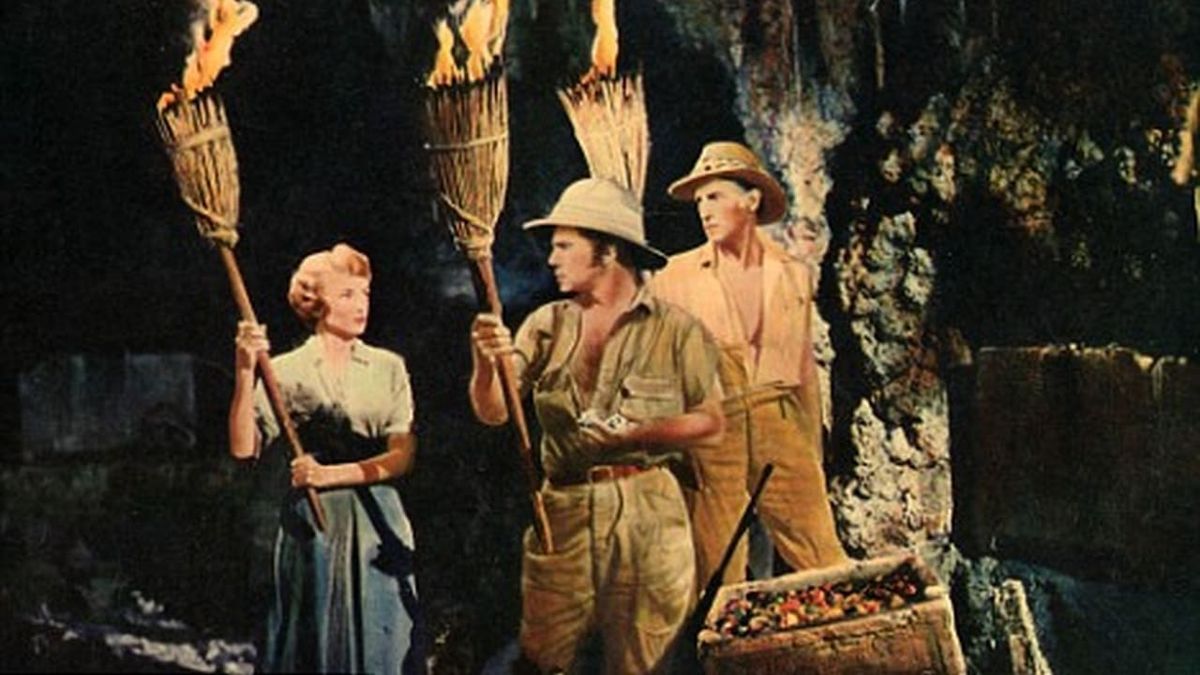

The three witness a duel to decide who is the rightful King between "Twala" and "Umbopa". Although he cheats "Twala" is killed. After "Umbopa" is recognized as "Chief" he provides an escort for his three friends with some of the diamonds and it is obvious ""Elizabeth": and "Allan" will marry.
Nine years later on July 1, 1959 MGM released a low budget supposed sequel to their version of H. Rider Haggard's novel entitled "Watsui" aka: "Return to King Solomon's Mines". The story does not have "Allan Quaterman", but his grown son "Harry Quatermain" portrayed by solid Hollywood "B" 1940's and 1950's action hero George Montgomery.

The screenplay was by future novelist James Clavell. Who would be known for 1962's "King Rat", 1966's "Tai
Pan" and 1975's "Shogun". However, he
started out as a screenplay writer and some of those credits include his first screenplay for 1958's original "The Fly". Then in 1963 he wrote the screenplay for "The
Great Escape" followed with screenplays based upon his own novels.
"Vam Brun" can't let them leave after being identified. There is a confrontation and "Quatermain's" long time friend and leader of the porters "Khiva" is killed along with "Van Brun". They are able to escape the angry natives that were protecting the criminal.

Immediately upon reaching the region the map indicates is the location of the mines. "Allan", "Elizabeth", "John" and "Umbopa" are met by natives. At this point the other three discover they have been traveling with royalty in exile returning to claim his throne. "Umbopa" reveals to the native the markings on his chest and the word goes out that the rightful "King" has returned.
The three searchers are escorted to the kraal of "King Twala", played by Baziga, a despot leader. While "Umbopa" goes another way with some of the other natives they have just met.
/_derived_jpg_q90_600x800_m0/KingSolomonsMines1950-Still8.jpg?partner=allmovie_soap)
There they meet the witch doctor a decades old "Gagool" portrayed by Sekaryongo. Who is told to take them to "King Solomon's Mines". "Allan", "Elizabeth" and "John" enter the mines which "Gagool" immediately seals them inside and leaves.
Inside they find the fate of the husband of "Elizabeth Curtis" freeing her to love and marry "Allan Quatermain", if they get out alive. The three find an underground stream that flows out of the mines. They swim to freedom meeting up with "Umbopa" followers and proceed to "Twala's" kraal. Where a civil war is taking place.


The three witness a duel to decide who is the rightful King between "Twala" and "Umbopa". Although he cheats "Twala" is killed. After "Umbopa" is recognized as "Chief" he provides an escort for his three friends with some of the diamonds and it is obvious ""Elizabeth": and "Allan" will marry.
Nine years later on July 1, 1959 MGM released a low budget supposed sequel to their version of H. Rider Haggard's novel entitled "Watsui" aka: "Return to King Solomon's Mines". The story does not have "Allan Quaterman", but his grown son "Harry Quatermain" portrayed by solid Hollywood "B" 1940's and 1950's action hero George Montgomery.

This picture used a lot of footage from the 1950 motion picture and wasn't shot in Africa at all.
The screenplay while called a sequel changes the ending of MGM's "King Solomon's Mines". Along with the time frame of both the previous motion picture and the original novel. Of course this is Hollywood and anything goes to create a good story.
Clavell had "Harry' Quatermain" returning to Africa to search for the diamond mines his father never found. There he meets "Erica Nueler" the daughter of a missionary played by Taina Elg. "Harry" does not like "Erica" at first. She's German and the German's torpedoed the ship his mother was on during World War 1. A fact anyone familiar with the novel, or both film versions knows is impossible as they predate 1900.
Of course the two will fall in love and find the mines his father never could.

Above George Montgomery as "Harry" on the left, and David Farrah as "Harry's" friend "Rick Cobb".

Released June 1, 1979 was "King Solomon's Treasure". The British film combined elements of both the original novel but was mostly based upon the sequel "Allan Quatermain" minus many characters.
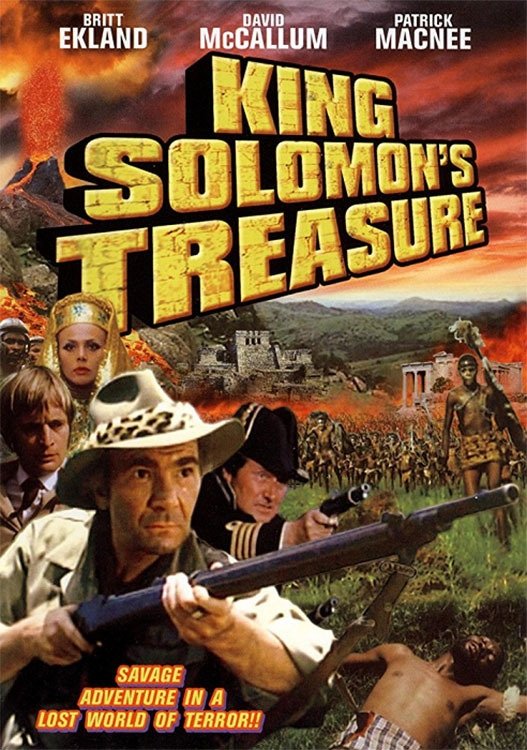
The film is extremely low budget and has "Alan Quatermain", "Sir Henry Curtis" and "Captain Good" of the Royal Navy looking for the legendary treasure of King Solomon and encountering dinosaurs. They also find the Queen of a Lost City, not "Ayesha", but "Nyleptha" and we have a romance between her and "Sir Henry".
David McCallum was "Sir Henry Curtis". McCullum has just appeared in the British mini-series of Robert Lewis Stevenson's "Kidnapped" and would immediately follow this film with the Walt Disney Company's "The Watcher in the Woods" starring Bette Davis.
Britt Ekland portrayed "Queen Nyleptha". The screenplay dropped her sister "Queen Sorais" who is also in love with "Curtis" in the novel and extremely evil. Besides television appearances on both sides of the Atlantic. Ekland had been in the Michael Caine 1971 "Get Carter", the original 1971 horror film "The Wicker Man" starring Edward Woodward and Christopher Lee, was "Mary Goodnight" in 1974's "James Bond" film "The Man With the Golden Gun" and appeared on the original "Battlestar Galactica".
Below David McCallum and Britt Ekland.
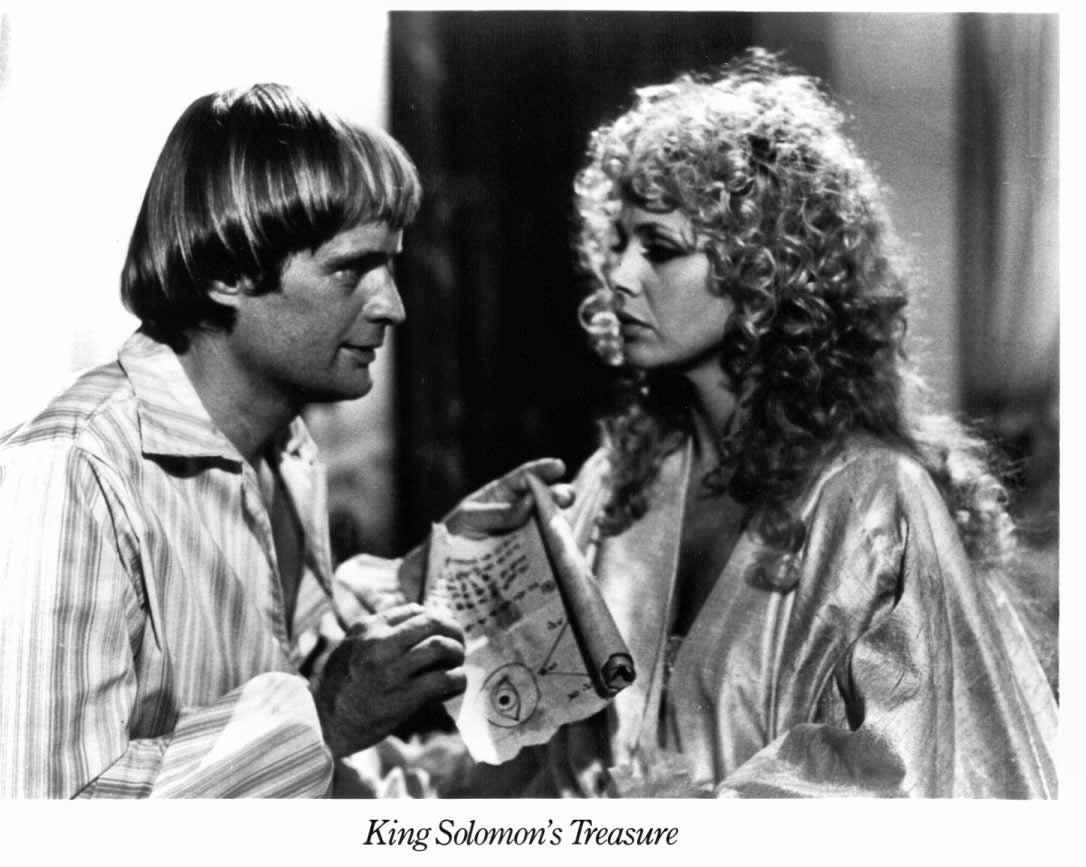
British character actor John Collicos was an excellent, and the only good performance, "Allan Quatermain". Collicos was known for his television villains appearing on "Star Trek: Deep Space Nine", the original "Battlestar Galactica", "The Six Million Dollar Man" and "Wonder Women" and others. From 1992 through 1995 John Collicos voiced "Apocalypse" on the "X-Men: the Animated Series".

Patrick Macnee was "Captain Good". Macnee is synonymous with the British television series "The Avengers" as "John Steed" from 1961 through 1969. Macnee was also seen on the original "Battlestar Galactica", played "Dr. Watson" to Christopher Lee's "Sherlock Holmes" in the forgotten, by many, "Sherlock Holmes and the Leading Lady".
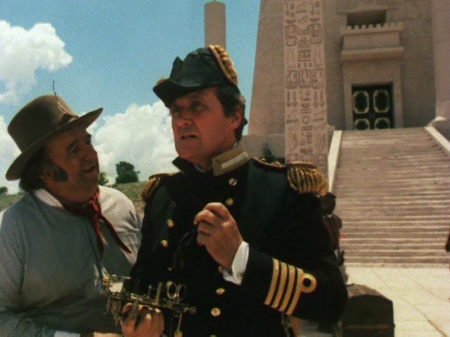
There's a fun review of this film by a fellow blogger at "Ninja Dixon" at:
http://ninjadixon.blogspot.com/2012/05/king-solomons-treasure-1979.html
Then in 1985 we had what should have been titled "Indian Jones Meets King Solomon's Mines".

Steven Spielberg and George Lucas had released their second "Indiana Jones" feature in 1984. Now Yorham Globus and Meneham Golan released on November 22, 1985 their version of "King Solomon's Mines".
The screenplay was by Gene Quintaro who had already written an
"Indiana Jones" parody for the 1983 3-D feature "Treasure
of the Four Crowns" and would go on to write "Police
Academy" 3, 4 and 5. Along with 1993's "National
Lampoon's Loaded Weapon 1". Quintaro had his tongue firmly in cheek
for this picture and only three characters, rewritten, remained from the
novel.
The musical score was by Jerry Goldsmith. Who among other films and
television program wrote the scores for "The Man from
U.N.C.L.E.", "Star Trek the Next
Generation", "Star Trek: Voyager, "Star Trek: the
Motion Picture", the original "Poltergeist" and
the original "Planet of the Apes". Goldsmith
proceeded to rip off his friend John Williams theme song for "Indian
Jones" to make his variation the theme song for "Allan
Quatermain",
The motion picture was directed by J. Lee Thompson. His previous
directing work included 1961's "The Guns of Navarone", the
original 1962 "Cape Fear", 1962's "Taras
Bulba", 1969's "Mackenna's Gold", 1972's "Conquest
of the Planet of the Apes". 1973's "Battle for the
Planet of the Apes" and 1977's "The White
Buffalo".
Richard Chamberlain was "Allan Quatermain". TV's "Dr.
Kildare" had portrayed "Octavius Caesar" in the 1970
film version of William Shakespeare's "Julius
Caesar" starring Charlton Heston, had played "Lord
Bryron" in the British 1972 film "Lady Caroline
Lamb". He was "Aramis" in Richard Lester's "The
Three Musketeers" in 1973 and again in the second part "The
Four Musketeers" in 1974. Lester broke the all star film up,
because the running time would have been near five hours.

Sharon Stone was "Jesse Huston". This was Sharon Stone's
first motion picture. She had been appearing on television in commercials
since 1978. Stone got the role, because of a misunderstanding. The producers
wanted Kathleen Turner from "Romancing the Stone" and
not knowing her name, They asked for "that Stone Women". After this
picture Sharon Stone was in a made for television movie and the 1986 sequel
to "King Solomon's Mines". Followed
by 1987's "Police Academy 4".

Herbert Lom was German officer "Colonel Bockner". Lom
had been acting since 1937 and over his career he appeared in many roles. In
1955 he was in the classic British original version of "The Lady
Killers" with Alec Guinness and Peter Sellers. In 1956 Herbert
Lom was "Napoleon" in the epic "War and
Peace" starring Audrey Hepburn and Henry Fonda. 1960 saw him in Stanley Kubrick's "Spartacus" starring
Kirk Douglas, 1961 saw the actor as "Captain Nemo" in Ray
Harryhausen's "The Mysterious Island" and the same
year he was in the Charlton Heston and Sophia Loren "El
Cid". Herbert Lom also portrayed the title character in Hammer Films
1962 "The Phantom of the Opera".


John Rhye-Davies provides another the tie in to the "Indiana
Jones" films as "Dogati". Rhye-Davies was "Sallah" in
1981's "Raiders of the Lost Ark" and 1989's "Indiana
Jone and the Lost Crusade". In 2001 the actor first appeared as
"Grimli" in Peter Jackson's "The Lord of the
Rings" trilogy. He would also provide the voice for
"Treebeard".
Ken Gampu was "Umbopo" and not "Umbopa". The
South African actor had been seen in Cornel Wilde's excellent "The
Naked Prey" in 1965, in 1978 was one of the mercenaries known
as "The Wild Geese" in the movie starring Richard
Burton, Richard Harris and Roger Moore and featuring Hardy Kruger and Stewart
Granger.
June Buthelezi was "Gagoola" not
"Gagool". This was the third of her four feature films.
The screenplay turns H. Rider Haggard's novel into a semi-comedy
and it works. Sharon Stone is more a "Perils of
Pauline" serial heroine that a frustrated, straight man,
"Allan Quatermain" has to rescue. Herbert Lom, plays a
"Colonel Klink" German officer right out of 1970's televisions "Hogan's
Heroes". While "Umbopo" is a major character and friend
of "Allan Quatermain" for many years before this picture's story begins.
The plot brings in a German military expedition lead by
"Colonel Bockner" looking for the mines. They are guided by "Quatermain's" competition "Dogati". A combining of
"Sallah" and "Dr. Rene Belloq" from "Raiders
of the Lost Ark".
"Allan" is guiding "Jesse" to find her missing
father "Professor Huston", portrayed by Bernard Archard. He of course went
looking for "King Solomon's Mines". The Professor
and "Jesse's" last name is believed to have been an inside reference
to director John Huston. Who had shot "The African
Queen" in the same area.
The beginning of the film has "Allan" and
"Jesse" arriving at an African town. Within seconds "Jesse" getting into
trouble that "Allan" must deal with. Which includes a rip off of the Karen Allen carpet abduction from
"Raiders".
"Quatermain" rescues her only to have "Jesse" insult the
native wearing the hat in the following still. He next wants to buy her from "Allan". He'll show up again later.

The German's capture "Jesse" and we have "Allan" rescuing her on a fast moving train and finding her father near death from torture by the Germans. "Quatermain" agrees to continue her father's quest and with "Jesse" continue.

As I said "Jess Huston" is a old style Chapter Serial
Heroine in danger and being rescued. Later "Jesse" and
"Allan" get invited FOR diner by the same native in the hat. It turns out
he's the chief of a group of cannibals.



Their able to escape by rolling the pot off the fire and down a
hill. As the cannibals close in on them the German's show up and start killing
them all giving "Allan" and "Jesse" time to escape.
As the two expeditions crisscross each other there is an scene
ripping off the German Airfield sequence from "Raiders". In it
"Allan" and "Jesse" plan to steal a German bi-plane, but
everything goes wrong. "Jesse" gets in the back cockpit and follows
"Allan's" instructions to start the plane and proceeds to knock him
over. As the plane and "Jesse" proceed in circles around the air
field. Finally, "Allan" catches it as "Jessie" takes
off with him hanging onto a wing. My reader gets the picture as Jerry
Goldsmith's rip off of John Williams "Indiana Jones" theme plays in
the background.

Being pursued "Allan" and "Jesse" are captured
by the Kukuana's. "Gagoola" has "Quatermain" hung upside
down over a pool of crocodiles. There is no "Twala" in this version.
"Umbopa" arrives and fights off some of the natives and
helps to rescue "Allan". Then reveals himself to be the
true "Chief of the Kukuana's". Which surprises
"Quatermain", but as this is going on. "Gagoola" kidnaps
"Jesse" and takes her to the mines to be sacrificed, because she
resembles the Queen of Sheba.
"Allan" and "Umpoba" now go to rescue
"Jesse" as "Dogati" and "Bockner" arrive.
The Germans now follow "Quatermain" and counter a
quicksand pool on their way to "King Solomon's Mines". "Bockner"
wants his men to carry him, across the quicksand, but "Dogati" has a
better idea. He kills some of the German soldiers and his own men and
uses their bodies as stepping stones to cross.
The climax comes within the mines. "Jesse' is rescued by
"Allan" and "Umbopa". "Gagoola" rather than face
"Umbopa" slides down a volcanic shaft and is incinerated.
Inside the mine cave "Dogati" forces "Bockner" to shallow some of the diamonds with the intention of cutting him open later. Meanwhile, the volcano is starting to erupt reacting to "Gagoola" reaching the lava and the ceiling of the diamond chamber cracks and falls burying "Dogati".
"Allan", "Jesse" and "Umbopo" are fleeing the collapsing chamber only to meet "Bockner". He demands they turn over their diamonds. "Quatermain" agrees placing them on the center stepping stone that will trigger an ancient trap. It works and "Bockner" meets his fate in the jaws of the "Mokele-mbembe". In the Congo it is described as either a water living entity, or spirit. Suddenly "Dogati" appears and fights "Quatermain" and finally falls into the lava.
As "Jesse" and "Allan" exit the Kukuana village at the film's conclusion. Both reveal they each kept a large diamond.

The movie was a financial success and Richard Chamberlain was back as "Allan Quatermain" and Sharon Stone now as his wife "Jesse Quatermain" in "Allan Quatermain and the Lost City of Gold". The motion picture was first released December 18, 1986 in West Germany.

Gene Quintano is back as the screenplay writer and he uses H. Rider Haggard's novel "Allan Quatermain" as the basis for this adventure. Where "King Solomon's Treasure" used the same novel, but dropped one of the two sisters from the lost city "Queen Sorais". This screenplay keeps "Queen Sorais" and drops "Queen Nyleptha".
James Earl Jones portrays "Umslopogass" which is "Umbopa's" full name. Jones the voice of "Darth Vader" in the original "Star Wars" trilogy had been the narrator and genie in a television production of "Aladdin and His Magic Lamp". He followed this movie with an appearance on Michael Landon's television series "Highway to Heaven".

Cassandra Peterson portrays "Queen Sorais". Peterson is better known as "Elvira Mistress of the Dark". As in her persona of "Elvira" the red headed Cassandra Peterson wore a black wig.

A man is chased by two masked natives and makes it to the "Quatermain" residence. There the delirious man says his brother, who was supposedly dead, is alive and has found the fabled "Lost City of Gold". That night the two masked natives return and kill him.
"Allan", "Jesse" and "Umslopogass" gather a group together and go in search of the lost city and to rescue the brother.
Inside the mine cave "Dogati" forces "Bockner" to shallow some of the diamonds with the intention of cutting him open later. Meanwhile, the volcano is starting to erupt reacting to "Gagoola" reaching the lava and the ceiling of the diamond chamber cracks and falls burying "Dogati".
"Allan", "Jesse" and "Umbopo" are fleeing the collapsing chamber only to meet "Bockner". He demands they turn over their diamonds. "Quatermain" agrees placing them on the center stepping stone that will trigger an ancient trap. It works and "Bockner" meets his fate in the jaws of the "Mokele-mbembe". In the Congo it is described as either a water living entity, or spirit. Suddenly "Dogati" appears and fights "Quatermain" and finally falls into the lava.
As "Jesse" and "Allan" exit the Kukuana village at the film's conclusion. Both reveal they each kept a large diamond.

The movie was a financial success and Richard Chamberlain was back as "Allan Quatermain" and Sharon Stone now as his wife "Jesse Quatermain" in "Allan Quatermain and the Lost City of Gold". The motion picture was first released December 18, 1986 in West Germany.

Gene Quintano is back as the screenplay writer and he uses H. Rider Haggard's novel "Allan Quatermain" as the basis for this adventure. Where "King Solomon's Treasure" used the same novel, but dropped one of the two sisters from the lost city "Queen Sorais". This screenplay keeps "Queen Sorais" and drops "Queen Nyleptha".
James Earl Jones portrays "Umslopogass" which is "Umbopa's" full name. Jones the voice of "Darth Vader" in the original "Star Wars" trilogy had been the narrator and genie in a television production of "Aladdin and His Magic Lamp". He followed this movie with an appearance on Michael Landon's television series "Highway to Heaven".

Cassandra Peterson portrays "Queen Sorais". Peterson is better known as "Elvira Mistress of the Dark". As in her persona of "Elvira" the red headed Cassandra Peterson wore a black wig.

A man is chased by two masked natives and makes it to the "Quatermain" residence. There the delirious man says his brother, who was supposedly dead, is alive and has found the fabled "Lost City of Gold". That night the two masked natives return and kill him.
"Allan", "Jesse" and "Umslopogass" gather a group together and go in search of the lost city and to rescue the brother.
Henry Silva is the evil priest "Agon". Silva's
films include the original 1960 "Ocean's 11" starring
Frank Sinatra and his Rat Pack, 1962's "The Manchurian
Candidate" and 1990's "Dick Tracy". As in the previous film you can't keep "Jesse" out of trouble.
In the end "Quatermain" and company lead the people in revolt against the "Queen Sorais" and "Agon".

In 1986 an Australian animation company with studios not in Australia, but Burbank, California had been releasing several films based upon literature in the Public Domain. One of these was their version of "King Solomon's Mines". I could not fine a description of the story.
In 2004 the Hallmark Channel released a two part miniseries of "King Solomon's Mines" starring Patrick Swayze as "Allan Quatermain". Just before this miniseries Patrick Swayze the star of 1987's "Dirty Dancing" was seen as the dancing coach in 2004's "Dirty Dancing: Havana Nights".
Alison Doody was
"Elizabeth Maitland". Basically a television miniseries actress. You
can't forget her as the Nazi archaeologist ""Dr. Elsa Schneider"
in 1989's "Indiana Jones and the Last Crusade".
Roy Marsden was "Captain John Goode". British actor Marsden worked in many BBC and ITV genres including appearing in
1970's "The Taming of the Shrew", 1976's "Space:
1999", 1993's "Sherlock Holmes",
2007's "Dr. Who", In this version "Goode"
is actually "Elizabeth's" Uncle.
Ian Roberts is "Sir Henry Curtis". Roberts is a South African actor. In 1995 he was in "Cry the Beloved Country" starring James Earl Jones and Richard Harris. American might also have seen the actor in the 1998 "Tarzan and the Lost City". In this version "Curtis" is an old African hunter, rival and friend of "Quatermain".
Ian Roberts is "Sir Henry Curtis". Roberts is a South African actor. In 1995 he was in "Cry the Beloved Country" starring James Earl Jones and Richard Harris. American might also have seen the actor in the 1998 "Tarzan and the Lost City". In this version "Curtis" is an old African hunter, rival and friend of "Quatermain".
Sidede Onyulo was "Umbopa". He is a Kenyan actor.
The miniseries was directed by stunt performer, film and
television director Steve Boyum. His stunt work included 1979's "Apocalypse Now" and
1989's "Lethal Weapon 2". His directing work
included 2000's "Mom Married a Vampire" and 2003's "Timecop
2" and the current CBS miniseries "Blood &
Treasure".
The screenplay by Stephen H. Berman was written for the Hallmark Channel. In 2005 he was one of nine producers of the Nicole Kidman and Will Ferrell
movie "Bewitched" based upon the 1960's television
series.
The story is actually very good, but like the previous motion
pictures takes liberties with the novel.
Wealthy British explorer "Samuel Maitland", actor John
Standing, has written a letter to his daughter "Elizabeth"
enclosing a map to "King Solomon's Mines". Shortly
after writing "Professor Maitland" is captured by the KuaKuani's. Note the name change.
Their King "Twala", actor Hakeem Kae-kazim below, wants the "Stone of
the Ancestors" found within the mines. Which the KuaKuana's in this story
do not know the location. A major story difference from the novel.
"Quartermain" has returned to London from a safari
seen at the opening of the miniseries. He wants to see his son
"Harry", but his lawyer informs him that the boy's grandparents, on
his late wife's side, have filed for custody. The only way he can stop them is
by acquiring a very large amount of money.
Enter "Elizabeth" and her Uncle. They visit "Allan Quartermain's" hotel room, finding it empty,"Goode" leaves his card that they were there. The three are having diner together at the hotel when "Curtis" appears and challenges "Quartermain" to a fight over an old disagreement. "Elizabeth" is shocked and thinks "Allan", reputation aside, is not the guide she wants. Later some thugs attack "Elizabeth" and "Allan" drives them away. They have also ransacked her hotel room looking for the map. "Elizabeth's" attackers are Russians, wanting the diamonds for the Czar. "Elizabeth", "Goode", "Curtis" and "Quatermain" now set off for Africa to find her father and the diamond mines.

"Elizabeth" he thinks "Allan" is irradiating learns from "Curtis" about the death of his wife, who loved Africa, the situation with "Harry" and starts to realize she might actually be in love with him.
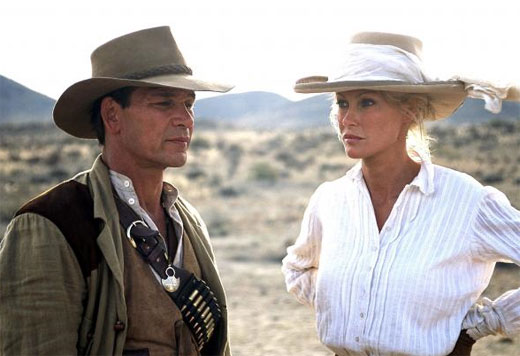
Enter "Elizabeth" and her Uncle. They visit "Allan Quartermain's" hotel room, finding it empty,"Goode" leaves his card that they were there. The three are having diner together at the hotel when "Curtis" appears and challenges "Quartermain" to a fight over an old disagreement. "Elizabeth" is shocked and thinks "Allan", reputation aside, is not the guide she wants. Later some thugs attack "Elizabeth" and "Allan" drives them away. They have also ransacked her hotel room looking for the map. "Elizabeth's" attackers are Russians, wanting the diamonds for the Czar. "Elizabeth", "Goode", "Curtis" and "Quatermain" now set off for Africa to find her father and the diamond mines.

"Elizabeth" he thinks "Allan" is irradiating learns from "Curtis" about the death of his wife, who loved Africa, the situation with "Harry" and starts to realize she might actually be in love with him.

Pursuing the group are the Russians led by the fanatical "Ivan
Freekov" played by South African actor Nick Boraine.

The Russians guide is "Bruce McNabb" portrayed by South African actor and director Gavin Hood. "McNabb" has a score to settle with "Quatermain". Hood has directed the 2009 movie "X-Men Origins: Wolverine" and 2013's "Ender's Game" among others.
At one point "Allan" and the others are ambushed by the Russians, but manage to escape. They enter a native village and learn some information that they must now cross the Sahara desert to go to the land they seek. "Quatemain" stops his group and waits for a man who has been following them to catch up. He is "Umbopa" and he knows, so he says, about where they are bound and joins "Allan's" party.

The Russians guide is "Bruce McNabb" portrayed by South African actor and director Gavin Hood. "McNabb" has a score to settle with "Quatermain". Hood has directed the 2009 movie "X-Men Origins: Wolverine" and 2013's "Ender's Game" among others.
At one point "Allan" and the others are ambushed by the Russians, but manage to escape. They enter a native village and learn some information that they must now cross the Sahara desert to go to the land they seek. "Quatemain" stops his group and waits for a man who has been following them to catch up. He is "Umbopa" and he knows, so he says, about where they are bound and joins "Allan's" party.
"Quatermain" and his party following the map find a giant rock formation of a cobra's head. Which is suppose to hold the main clue to locating the mines. However, the Russians arrive and kidnap both "Elizabeth" and her Uncle.
This actually ends the first part of the miniseries.
Another change to the basic
story comes with "Gagool" played by Lesedi Mogoathle.

Although "Twala" is keeping "Professor Maitland" alive to force him to help find the "Stone of the Ancestors". He is also barely feeding him. "Gagool" is still the witch doctor, but not an evil person. She likes "Maitland" and brings him extra food and speaks to him often. She can see the future and knows that "Umbopa" is coming and "Twala's" cruel rule is to end.
"Quatermain" and the others set a trap for the Russians to retrieve the map. It works, but "Allan's" friend and head man "Khiva", actor Godfrey Lekaia, is killed, but "McNabb" is wounded and now it is just him and "Fleekov": left on the other side.

As "Allan" and his group continue on., They are surrounded by KuaKuani warriors and "Umbopa" now reveals who he to the natives and that his true name is "Ignosi" the rightful King.
In the end there is a small battle and "Henry Curtis" dies. After blocking a swear thrown at "Allan" by "Twala". Then to "Quatermain's" surprise the KiaKuani's encircle and kill "Twala" for the evil he has brought them. "Elizabeth: is reunited with her father."Freekov" is mentally sufficated by "Gagool", but tells "McNabb"she will not kill him. She has seen his future and he may find what he seeks, but he will never posses it. He runs out of her hut and towards the mines. "Gagool" next asks "Ignosi", if she may stay on as the tribes witch doctor and is permitted by him.
"Allan" and "Elizabeth" now head for "King Solomon's Mines". There "McNabb" ambushes "Quatermain" only to fall down a flight of stairs to his death. "Gagool's" prophecy has been fulfilled. "Elizabeth" and "Allan" find the "Stone of the Ancestors", but when its touched the mines start to cave in trapping the two. They find a way out and "Allan" tosses the stone back into the mines.
The miniseries cuts to "Allan's" African home, He is married to "Elizabeth" and has his son "Henry".,
The last motion picture based upon Haggard's novel, as of this writing, went straight to video and comes from the movie group known as "The Asylum" released April 29, 2008.
"Allan Quatermain and the Temple of Skulls" starred Sean Cameron Mitchell as "Allan".Mitchell was regular in several films from "The Asylum".
As to the title sounding so much like 1984's "Indiana Jones and the Temple of Doom". Please note the tag line on the following poster for the release.
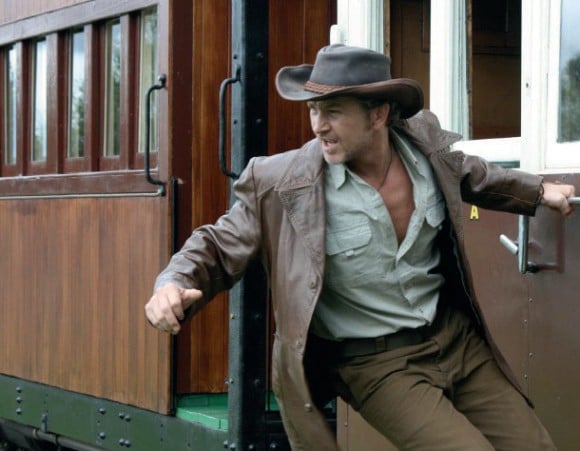
A British group hires "Allan Quatermain" to guide an expedition looking for "King Solomon's Mines".

Above is Natalie Stone as "Lady Anne Heresford". Most of her 16 film appearances were on video shorts. Below is actress Witty Jourdan as a female "Umbopa".
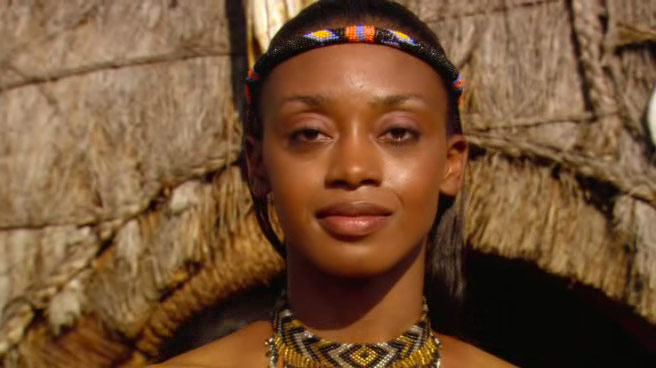

Although "Twala" is keeping "Professor Maitland" alive to force him to help find the "Stone of the Ancestors". He is also barely feeding him. "Gagool" is still the witch doctor, but not an evil person. She likes "Maitland" and brings him extra food and speaks to him often. She can see the future and knows that "Umbopa" is coming and "Twala's" cruel rule is to end.
"Quatermain" and the others set a trap for the Russians to retrieve the map. It works, but "Allan's" friend and head man "Khiva", actor Godfrey Lekaia, is killed, but "McNabb" is wounded and now it is just him and "Fleekov": left on the other side.

As "Allan" and his group continue on., They are surrounded by KuaKuani warriors and "Umbopa" now reveals who he to the natives and that his true name is "Ignosi" the rightful King.
In the end there is a small battle and "Henry Curtis" dies. After blocking a swear thrown at "Allan" by "Twala". Then to "Quatermain's" surprise the KiaKuani's encircle and kill "Twala" for the evil he has brought them. "Elizabeth: is reunited with her father."Freekov" is mentally sufficated by "Gagool", but tells "McNabb"she will not kill him. She has seen his future and he may find what he seeks, but he will never posses it. He runs out of her hut and towards the mines. "Gagool" next asks "Ignosi", if she may stay on as the tribes witch doctor and is permitted by him.
"Allan" and "Elizabeth" now head for "King Solomon's Mines". There "McNabb" ambushes "Quatermain" only to fall down a flight of stairs to his death. "Gagool's" prophecy has been fulfilled. "Elizabeth" and "Allan" find the "Stone of the Ancestors", but when its touched the mines start to cave in trapping the two. They find a way out and "Allan" tosses the stone back into the mines.
The miniseries cuts to "Allan's" African home, He is married to "Elizabeth" and has his son "Henry".,
The last motion picture based upon Haggard's novel, as of this writing, went straight to video and comes from the movie group known as "The Asylum" released April 29, 2008.
"Allan Quatermain and the Temple of Skulls" starred Sean Cameron Mitchell as "Allan".Mitchell was regular in several films from "The Asylum".
As to the title sounding so much like 1984's "Indiana Jones and the Temple of Doom". Please note the tag line on the following poster for the release.

A British group hires "Allan Quatermain" to guide an expedition looking for "King Solomon's Mines".

Above is Natalie Stone as "Lady Anne Heresford". Most of her 16 film appearances were on video shorts. Below is actress Witty Jourdan as a female "Umbopa".

All the descriptions just say "Allan Quatermain" has to avoid dangers looking for the Temple of Skulls. Like most films from "The Asylum" this was a "mockbuster' of "Indiana Jones and the Kingdom of the Crystal Skulls". I'll take Chamberlain and Stone anytime over this mess.
My readers can be sure "Allan Quatermain", or "Ayesha" will be back sometime.
My readers can be sure "Allan Quatermain", or "Ayesha" will be back sometime.



.jpg)














_11.jpg)
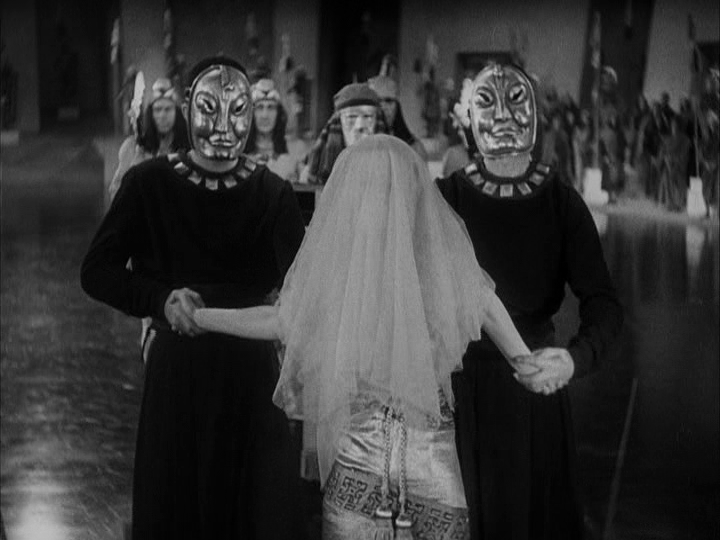
_08.jpg)

_07.jpg)





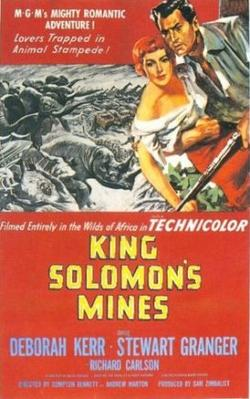




.jpg)


No comments:
Post a Comment